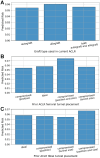A Novel Machine Learning Model to Predict Revision ACL Reconstruction Failure in the MARS Cohort
- PMID: 39555321
- PMCID: PMC11565622
- DOI: 10.1177/23259671241291920
A Novel Machine Learning Model to Predict Revision ACL Reconstruction Failure in the MARS Cohort
Abstract
Background: As machine learning becomes increasingly utilized in orthopaedic clinical research, the application of machine learning methodology to cohort data from the Multicenter ACL Revision Study (MARS) presents a valuable opportunity to translate data into patient-specific insights.
Purpose: To apply novel machine learning methodology to MARS cohort data to determine a predictive model of revision anterior cruciate ligament reconstruction (rACLR) graft failure and features most predictive of failure.
Study design: Cohort study; Level of evidence, 3.
Methods: The authors prospectively recruited patients undergoing rACLR from the MARS cohort and obtained preoperative radiographs, surgeon-reported intraoperative findings, and 2- and 6-year follow-up data on patient-reported outcomes, additional surgeries, and graft failure. Machine learning models including logistic regression (LR), XGBoost, gradient boosting (GB), random forest (RF), and a validated ensemble algorithm (AutoPrognosis) were built to predict graft failure by 6 years postoperatively. Validated performance metrics and feature importance measures were used to evaluate model performance.
Results: The cohort included 960 patients who completed 6-year follow-up, with 5.7% (n = 55) experiencing graft failure. AutoPrognosis demonstrated the highest discriminative power (model area under the receiver operating characteristic curve: AutoPrognosis, 0.703; RF, 0.618; GB, 0.660; XGBoost, 0.680; LR, 0.592), with well-calibrated scores (model Brier score: AutoPrognosis, 0.053; RF, 0.054; GB, 0.057; XGBoost, 0.058; LR, 0.111). The most important features for AutoPrognosis model performance were prior compromised femoral and tibial tunnels (placement and size) and allograft graft type used in current rACLR.
Conclusion: The present study demonstrated the ability of the novel AutoPrognosis machine learning model to best predict the risk of graft failure in patients undergoing rACLR at 6 years postoperatively with moderate predictive ability. Femoral and tibial tunnel size and position in prior ACLR and allograft use in current rACLR were all risk factors for rACLR failure in the context of the AutoPrognosis model. This study describes a unique model that can be externally validated with larger data sets and contribute toward the creation of a robust rACLR bedside risk calculator in future studies.
Registration: NCT00625885 (ClinicalTrials.gov identifier).
Keywords: ACL revision; femoral tunnel; graft failure; machine learning; tibial tunnel.
© The Author(s) 2024.
Conflict of interest statement
One or more of the authors has declared the following potential conflict of interest or source of funding: This study was funded by the National Institutes of Health/National Institute of Arthritis and Musculoskeletal and Skin Diseases (grant 5R01-AR060846). See Supplemental Material for individual disclosures. AOSSM checks author disclosures against the Open Payments Database (OPD). AOSSM has not conducted an independent investigation on the OPD and disclaims any liability or responsibility relating thereto.
Figures



References
-
- Alaa A, van der Schaar M. AutoPrognosis: automated clinical prognostic modeling via Bayesian optimization with structured kernel learning. Presented at: Proceedings of the 35th International Conference on Machine Learning; July 10-15, 2018; Stockholm, Sweden. Accessed October 13, 2024. https://proceedings.mlr.press/v80/alaa18b.html
-
- Anaconda. Anaconda software distribution. Accessed October 13, 2024. https://anaconda.com
-
- Beam AL, Kohane IS. Big data and machine learning in health care. JAMA. 2018;319(13):1317-1318. - PubMed
-
- Bedi A, Maak T, Musahl V, et al.. Effect of tibial tunnel position on stability of the knee after anterior cruciate ligament reconstruction: is the tibial tunnel position most important? Am J Sports Med. 2011;39(2):366-373. - PubMed
Associated data
LinkOut - more resources
Full Text Sources
Medical
Research Materials
Miscellaneous

